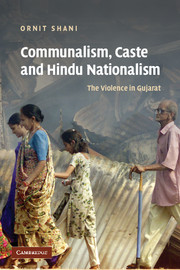Book contents
- Frontmatter
- Contents
- Acknowledgements
- Glossary
- List of abbreviations
- Map of Ahmedabad
- Introduction
- Part I The background
- Part II The 1985 Ahmedabad riots: the historical conjunction between caste conflicts and communalism
- 3 The official account
- 4 The ‘living-text’, or, the riots within the riot
- Part III The making of ethnoHinduism
- Bibliography
- Index
4 - The ‘living-text’, or, the riots within the riot
Published online by Cambridge University Press: 04 December 2009
- Frontmatter
- Contents
- Acknowledgements
- Glossary
- List of abbreviations
- Map of Ahmedabad
- Introduction
- Part I The background
- Part II The 1985 Ahmedabad riots: the historical conjunction between caste conflicts and communalism
- 3 The official account
- 4 The ‘living-text’, or, the riots within the riot
- Part III The making of ethnoHinduism
- Bibliography
- Index
Summary
This second account of the riots forms an attempt to find another path of interpretation for the shift in the riots from anti-reservation agitation to communal violence and for the collapse of law and order in the city. It does so by examining the moments of crisis of 1985 at the local level, in relation to the social circumstances of people who experienced the riots and on the basis of their oral accounts of the events. In interviews, people recounted at length their own and their families' circumstances at the time, something the official views did not account for. The chapter also aims to unravel the social contexts within which the shift in the political relevance of identities from caste to communalism took place, from the mid-1980s.
A reading of the events at the local level through the experiences of those who actually participated in them suggests that there can be no single coherent account, or vernacular explanation of the Ahmedabad riots. Oral testimonies suggest that there was much more to the riots than a simple shift from caste-reservations to communalism caused by political manipulation or a historical disposition to violence. Riots had different contents and were experienced differently in the various parts of the city. What are known as the riots of 1985 were in fact made up of numerous smaller riots that broke out among the diverse populations of the ‘three cities of Ahmedabad’ – the walled city, the eastern industrial belt, and the western city.
- Type
- Chapter
- Information
- Communalism, Caste and Hindu NationalismThe Violence in Gujarat, pp. 108 - 132Publisher: Cambridge University PressPrint publication year: 2007

